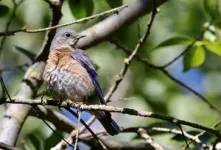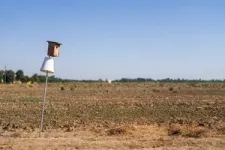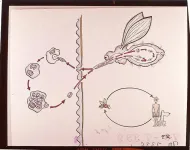(Press-News.org) Bird populations are in rapid decline across North America. While climate change is just one of the many factors influencing North American birds, its effects are significant and can interact with other stressors, such as habitat loss. A team of University of California, Davis, researchers found that the effects of extreme temperatures on avian reproduction can vary depending on the type of environment that birds call home.
The findings, published in the journal Science, shed light on how climate change can combine with habitat loss to affect bird reproduction across the United States.
Researchers found that extreme high temperatures significantly diminish bird reproductive success in agricultural landscapes. Birds nesting near farmland were half as likely to have at least one fledgling successfully leave the nest when temperatures spiked. However, forests seemed to provide a protective buffer against high temperatures, offering shaded areas that helped increase nesting success.
“The effects of heat are more intense for birds nesting in agriculture than birds nesting in forest, which means that canopy cover probably constitutes an important climate refuge for birds that can thrive in various habitats,” said Katherine Lauck, co-lead author of the paper and a Ph.D. candidate in ecology at UC Davis.
When they looked at how heat waves affected nesting success in urban areas, the researchers found less of a negative impact than in agriculture, probably because nests were often in city parks and residential areas that can have high tree cover.
“This suggests that places like backyards and parks may provide important bird habitat that is somewhat more buffered from climate extremes in the future,” Lauck said.
Extensive dataset analysis
Department of Wildlife, Fish and Conservation Biology Associate Professor Daniel Karp launched this project with his students to keep the lab in contact during the COVID-19 pandemic. They analyzed data from NestWatch, an initiative created by Cornell University’s Laboratory of Ornithology, where people from across the country monitor bird nests near them and use an app to record information on types of bird species, nest locations, number of eggs laid, baby bird activity and more.
“What is really unique about this dataset is that we could look at bird reproduction at a very broad spatial scale,” Karp said. “With these data, we could begin to unravel how climate change and habitat loss are together affecting many North American birds.”
The team of researchers analyzed more than 152,000 nesting records featuring nearly 60 bird species that were nesting in farms, forests, grasslands and developed areas across the country during the span of 23 years (1998-2020).
Heightened risks
The researchers also studied which types of species were most vulnerable to heat waves in agriculture. Negative impacts were broadly felt across all bird species studied, with western bluebirds and tree swallows, two species common on farms, both experiencing significant declines in nesting success when temperatures spiked in agricultural areas.
“We see these strong effects in common and habitat generalist birds, which we often think of as more resilient to land use change and climate change,” Lauck explained.
Threatened birds and birds that build open-cup nests, which lack any covering, were even more vulnerable to heat waves in farming areas compared to common species and those that build their nests in tree holes and nest boxes.
“The nearly 50% decline in nesting success that we saw on average jumps to 70% when we consider species of higher conservation concern,” Karp said. “This suggests that species already in decline may have an even greater difficulty rearing young in the future as heat waves become more common and more land is converted to agriculture.”
Future predictions and solutions
The study also painted a picture of what the future may look like. By the year 2100, their models predicted that nesting success in agricultural areas would decline by an additional 5% on average under current greenhouse gas emission trajectories. The study suggests that curtailing emissions and promoting thermal refuges, either by planting or maintaining patches of natural vegetation, are likely crucial to conserving birds. Keeping shade may also be needed to maintain bird populations living in urban and agricultural areas.
“Farmers often build nest boxes to attract birds to their farms and help control insect pests. Maybe it makes sense to put those boxes in shaded locations,” Karp said. “They might also consider planting hedgerows and conserving patches of native vegetation to provide shade and help birds beat the heat. Thinking about some of those interventions might matter a lot for birds looking forward.”
Alison Ke, Daniel Paredes, Kees Hood and Thomas Phillips with the UC Davis Department of Wildlife, Fish and Conservation Biology; Elissa Olimpi with Virginia Tech; and Bill Anderegg with the University of Utah also co-authored this study.
The project was funded by UC Davis Graduate Group in Ecology Fellowship, National Science Foundation Graduate Research Fellowship Program and Achievement Rewards for College Scientists Fellowship.
END
Heat waves harm bird reproduction on agricultural lands
Researchers analyzed data from more than 150,000 bird nests across the U.S.
2023-10-19
ELSE PRESS RELEASES FROM THIS DATE:
Astronomers detect most distant fast radio burst to date
2023-10-19
An international team has spotted a remote blast of cosmic radio waves lasting less than a millisecond. This 'fast radio burst' (FRB) is the most distant ever detected. Its source was pinned down by the European Southern Observatory’s (ESO) Very Large Telescope (VLT) in a galaxy so far away that its light took eight billion years to reach us. The FRB is also one of the most energetic ever observed; in a tiny fraction of a second it released the equivalent of our Sun’s total emission over 30 years.
The discovery of the burst, named FRB 20220610A, was made in June last year by the ASKAP radio telescope in Australia ...
Imprinted genes in the ‘parenting hub’ of the brain determine if mice are good parents
2023-10-19
Whether a mouse is a good or bad parent can be traced back to imprinted genes in key neurons in the “parenting hub” in the brain, according to a new study by Anthony Isles of Cardiff University and colleagues, published October 19 in the journal PLOS Genetics.
In mice, there is some evidence that an unusual phenomenon in mammals called genomic imprinting impacts parenting behavior. Mammals inherit two copies of each gene – one from each parent – and usually, each copy is expressed equally in the cell. With imprinted genes, however, only one copy is expressed, ...
With smartphone videos, clinicians can analyze human movement using open source "OpenCap" platform, 25x faster and at a fraction of the cost of labs
2023-10-19
With smartphone videos, clinicians can analyze human movement using open source "OpenCap" platform, 25x faster and at a fraction of the cost of labs.
####
Article URL: https://journals.plos.org/ploscompbiol/article?id=10.1371/journal.pcbi.101XXXX
Article Title: OpenCap: Human movement dynamics from smartphone videos
Author Countries: US
Funding: SDU, AF, LK, JM, ASC, JLH, and SLD were supported by the National Institutes of Health (https://www.nih.gov; grant 1P41EB027060-01A1) and the Wu Tsai Human Performance Alliance (https://humanperformancealliance.org). ASC and MK were supported by Philips Healthcare (https://www.usa.philips.com/healthcare) ...
New smartphone app quickly analyzes human motion to aid physical rehabilitation
2023-10-19
WHAT:
A research team funded by the National Institutes of Health has developed a smart phone app that can track and analyze a person’s ability to move from one place to another, known as locomotion, and other types of movements. Human motion analysis is used to evaluate patients with movement difficulties, to help clinicians plan surgery, and to assess the results of treatment procedures. The research team believes that using the app costs about 1% of conventional motion analysis techniques and works 25 times faster. The study appears in PLOS Computational Biology.
Researchers tested their app, called OpenCap, with 100 participants. Using two or more smart phones, ...
BNP peptide a culprit in eczema
2023-10-19
Researchers from North Carolina State University have pinpointed a particular peptide’s role in activating atopic dermatitis, or eczema. The work could lead to more effective treatments for the condition.
Atopic dermatitis (AD) is a skin condition characterized by itching, irritated and thickened skin at the site of the irritation. The brain natriuretic peptide (BNP) is a peptide, or short chain of amino acids, that is elevated in patients with AD.
“BNP is expressed in sensory neurons, the neurons responsible for conveying sensation to the brain via the spinal cord,” ...
Researchers confirm postpartum depression heritability, home in on treatment mechanism
2023-10-19
CHAPEL HILL, NC – Postpartum depression (PPD), a common subtype of major depressive disorder, is more heritable than other psychiatric conditions, yet the genetics of PPD are understudied compared to these other psychiatric conditions., such as anxiety and bipolar disorder.
To remedy that, UNC School of Medicine researchers led an international team of researchers to conduct the largest-ever meta-analyses of genome-wide association studies (GWAS) to investigate the genetic architecture of PPD.
Published in the American Journal of Psychiatry, their research shows that approximately 14 percent of the variation seen in PPD cases can be attributed to common genetic factors. A patient’s ...
OU-led study documents new extremes in stratospheric water vapor
2023-10-19
A University of Oklahoma-led article published in Geophysical Research Letters highlights newly measured extremes recorded during the National Aeronautics and Space Administration Dynamics and Chemistry of the Summer Stratosphere field project.
“Extreme Altitudes of Stratospheric Hydration by Midlatitude Convection Observed During the DCOTSS Field Campaign,” led by OU School of Meteorology Interim Director and Associate Professor Cameron Homeyer, summarizes the extremes in measured stratospheric depth of hydration by convection recorded during the DCOTSS project as a whole, and ...
Can golden retrievers live longer?
2023-10-19
Golden retrievers are one of the most popular breeds of dogs. But research shows they have up to a 65% chance of dying from cancer. In a new study, University of California, Davis, researchers set out to find if certain genetic factors could help their survival rate. But instead of searching for genes associated with a cancer diagnosis in the breed, they instead chose to look for genes associated with longer life.
The gene they found is in a family of proteins long known to be important in human cancers. Specific versions or variants ...
University of Cincinnati researcher joins pediatric immunotherapy network
2023-10-19
Each year, approximately 200 to 300 children in the United States are diagnosed with diffuse midline gliomas (DMG), a tumor that begins in the brain or spinal cord.
The tumors cannot be removed through surgery due to their location in the brain, and current treatments are not effective and lead to a nearly zero percent survival rate.
The University of Cincinnati’s Timothy Phoenix is part of a multi-investigator collaborative team with St. Jude Children’s Research Hospital’s Stephen Mack, PhD, and Giedre Krenciute, PhD, that received a nearly $4 million National Cancer Institute (NCI) ...
New study provides ‘genetic fingerprint’ indicating disease spread by sand flies may be gaining firm foothold in the United States
2023-10-19
CHICAGO (October 19) — Scientists have new evidence that a tropical disease once seen almost exclusively in returning travelers is now being detected in the United States in people with no international travel history — and caused by a Leishmania parasite strain that’s distinctly different from “imported” cases, according to an analysis from researchers at the U.S. Centers for Disease Control and Prevention (CDC) presented today at the Annual Meeting of the American Society of Tropical Medicine and Hygiene (ASTMH).
The study, led by CDC scientist Marcos de Almeida, emerged from a curious rise of domestic infections over the last 10 years, ...
LAST 30 PRESS RELEASES:
Pre-school health programme does not improve children’s diet or physical activity, prompting call for policy changes, study finds
Autumn clock change linked to reduction in certain health conditions
AI images of doctors can exaggerate and reinforce existing stereotypes
Where medicine meets melody – how lullabies help babies and parents in intensive care
We may never be able to tell if AI becomes conscious, argues philosopher
AI video translation shows promise but humans still hold the edge
Deep ocean earthquakes drive Southern Ocean’s massive phytoplankton blooms, study finds
Without campus leftovers to pick through, the beaks of this bird changed shape during the pandemic
High-dose antibiotic does not reduce mortality in tuberculous meningitis
How many insects fly in the sky above the USA?
Could cheese protect your brain health?
Who faces more difficulty recovering from stroke?
Colliding galaxies create the brightest, fastest growing black holes at their center
New BrainHealth research reveals tradeoffs on sleep with cannabis use for chronic pain
Aging-US now on ResearchGate, enhancing visibility for authors and readers
'Molecular glue' stabilizes protein that inhibits development of non-small cell lung cancer
Mount Sinai Health System is recognized in 2025 Chime Digital Health Most Wired survey
From prey to predator: How carnivores spread beneficial fungi
Menopause symptoms may be frequent and have negative effects, according to female endurance athletes
US Congressmembers’ responses on X to mass shooting events differ along party lines
KAIST-UEL team develops “origami” airless wheel to explore lunar caves
Individual genetic differences render some therapies ineffective
Engineering dendritic cells boosts cancer immunotherapy
Sophisticated neuroimaging reveals PTSD in WTC responders is linked to measurable physical changes in brain structure
Health policy experts identify promising strategies for providing health care to homeless people
Study explores role of neutrophils in canine atopic dermatitis
Mayo Clinic researchers develop AI-ECG model to diagnose liver disease earlier
Heavy menstruation common among teenage girls – questionnaire reveals risk of iron deficiency
New study explores why open water swimming feels so powerful for midlife women
In echo of Jurassic Park, mosquitoes capture entire ecosystems in their blood meals
[Press-News.org] Heat waves harm bird reproduction on agricultural landsResearchers analyzed data from more than 150,000 bird nests across the U.S.







